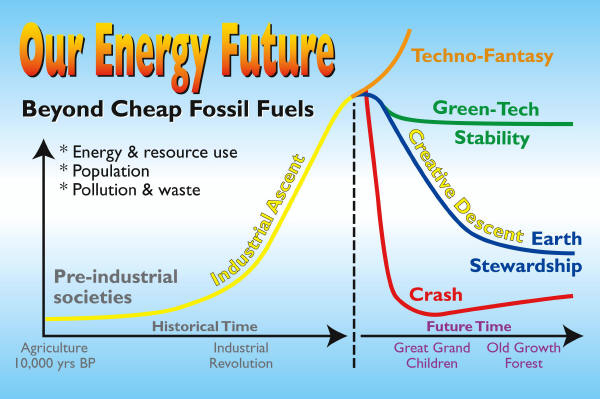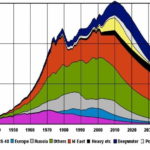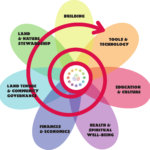
The Energy Descent Curve of David Holmgren
David Holmgren, one of the co-founders of the Permaculture movement, understood the concepts of peak oil and ecological devastation. His Energy Descent diagram (Holmgren, 2012) was about possible routes forward.
In Holmgren’s view, Western Civilization has gone through a tremendous ascent. We’ve climbed to the peak of the mountain with respect to consumerism, consumption of world resources, consumption of energy. We are at the very peak. What are our alternatives, post-peak? Holmgren described four alternatives.
Tech-fantasy scenario
The first scenario, Holmgren calls the Tech-fantasy scenario. Some people call it the Brown scenario. It says: Pay no attention to all those things we’ve just been discussing with respect to biocapacity, climate change, forget about all that and just go shopping. Ignore what’s going on in the world and just go shopping, keep the economy flying along at the levels to which everyone has become accustomed.
The problems with this should be obvious. We’re experiencing climate disruptions, we’re at peak or post-peak on multiple resources, we can’t continue on.
You’ll notice that Holmgren labeled this as a “fantasy” scenario.
Green-tech scenario
Holmgren calls his second scenario the green-tech stability model. It goes like this: We know that the growth thing isn’t good, so we won’t grow. We’ll just stay stable, and continue on right where we are. We’ll just sub out greener practices for all the things we have problems with. You say we’re running out of oil? Well then, we’ll just switch over to solar and wind energy. We’ll just make the swap.
It sounds nice, and a lot of environmentalists, knowingly or unknowingly, endorse this concept. You’ll even find economic models which fall into this category, like the Steady State Economy model. But there are four major problems with this green-tech stability model.
The first problem is the idea of energy density. Oil gives us tremendous clout, it is a highly energy-dense substance. It gives us a mind-boggling amount of energy per unit, and we really do not have a equivalent replacement. When you dig into the science of wind and hydrogen and solar, you’ll find out that each of them have significant limitations. They just do not have the energy density that we have become accustomed to with oil.
The second major problem with this scenario is infrastructure. This is something that industries and governments are scrambling to remedy, but if we are to make this jump from fossil-based operations to greener operations, the climate emergency says we have to do it now, not some point in the distant future. and right now we just we simply do not have the infrastructure to support it, right now, when we need to make the shift.
The third problem with the green tech scenario is an economic issue. Everything in our current economy, from corporate profits to the stock market to your expectations about your salary over the course of your career, to your expectations about the value of a house, interest rates, they’re all built on the concept of growth, we expect them all to be growing over time. The adjustment from a grow-grow-grow economy to a flat economy is a substantial adjustment. It will not be painless. we will feel the ouch.
Some people promote the idea of what they call a “green economy” — one that will continue to grow, grow, grow, just do it with green businesses, B corporations, greener practices like solar panels. Return to the Biocapacity unit if you don’t see what’s wrong with this picture.
That leads us into what is arguably the biggest problem with the green tech scenario: where we draw the line. Look at where it is in the image, right about where we are now. But where are we now? In North America, we gobble resources at about five-planets-worth-of-consumption. We can’t call a steady state at that level of consumption. We’ve got to adjust to something more in line with one single planet.
Collapse scenario
So what happens if we ignore the problem for a little bit longer, or we tie ourselves in knots debating about it and do nothing to change our ways? That’s where we have the red line scenario, the collapse scenario, the Mad Max scenario. As in, “I’ve got my gun, have you got yours?” This is the scenario of dire shortages and conflict over what is left. For more than 15 years I’ve been working to keep us out of this scenario. I hope you’ll join me.
Energy descent scenario
Holmgren offers us one additional scenario. This he calls the idea of creative descent, or energy descent. Some people call this the Permaculture scenario.
Holmgren points out that climbing up the mountain took tremendous amounts of human creativity and ingenuity to design all the things we see around us. He says why couldn’t we use similar amounts of creativity and ingenuity to design a way out of these problems? There’s one thing we need to notice about this scenario and it’s important.
The creative descent scenario is a descent. It necessarily includes a direction change, from five-planets-worth-of-consumption and more-more-more, back to something more in line with what one small planet can realistically deliver. That’s a significant adjustment.
Remember we said earlier that everything in our economy is geared toward more-more-more, eternal growth? The Permaculture scenario understands that we don’t have five, six, seven, or eight planets to derive resources from for all those fantasies of growth. This scenario understands that you can’t have infinite growth on a finite planet. We’ve got to make the adjustment. So the Permaculture scenario is one of designing a path that peels back away from five-planets-worth-of-consumption, to consuming resources in a way that is more appropriate, more just and fair, than most of us have ever seen in our lifetimes.
Would that [climate] were only an engineering challenge! Would that some engineers could … hole up and engineer their way to solutions! …
When you start to dig deeper, you start to see that the roots of the challenge are in extractive capitalism, which is entangled with racism, white supremacy, and patriarchy. … It would be easier to solve if it were only an engineering problem. But it just isn’t, because the things that are at stake are more complicated. And so the solutions that we need are also more complicated.
— Katharine Wilkinson, Vice President of Project Drawdown (Dalton, Johnson, & Wilkinson, 2020)
Reflection – Energy Descent
The UN has said that to hold global warming below the 1.5 degree Celsius threshold, global emissions need to fall by 7.6% each year from 2020 to 2030. By comparison, in 2020 with covid shutdowns, U.S. carbon emissions decreased by 10%. (CNN 2020)
With respect to your carbon emissions, how did your family’s life change during 2020? Consider air travel, automobile travel, goods purchased, and more. In 2021, rather than striving to return to the so-called “normal,” how might you trim your emissions by that much again — on top of the decreases you’ve already made?
This post is part of the What We Can Do series — see the full project.


